#redwood vegetable boxes
Explore tagged Tumblr posts
Photo

San Francisco Landscape Fire Pit Ideas for a mid-sized, fully-shaded, stone-paved backyard with a fire pit.
0 notes
Photo

San Francisco Outdoor Kitchen Example of a mid-sized minimalist backyard stone patio kitchen design
#neolith firepit#neolith countertop#redwood vegetable boxes#hog wire fencing#orinda landscape design#sustainable landscaping
0 notes
Photo

Landscape - Retaining Walls This is an illustration of a traditional, mid-sized backyard landscape with retaining walls.
#galvanized vegetable garde box#berkley landscape design#redwood decking#belgard retaining wall#fun garden for dogs#segmental concrete retaining walls
0 notes
Text

ALT
Flora of Thedas: Real Plants
List of all the real plants in Thedas, mentioned or seen.
Additional notes on certain items will be listed at the bottom, for items marked with asterisks, see the Game assets and Additional Notes and Trivia sections at the bottom. Sources are listed at the very end and this time linked.
For others lists here are posts for: Flora of Thedas Master List
Key: * - Name comes from the asset file name ** - Name not provided but identified based on the textures used on the asset. *** - See Additional Notes and Trivia.
General Flora: Flowers and Foliage
Acacia*: Black Wood*
Ash Tree
Aspen Tree
Banyan Tree*
Beech Tree
Belladonna
Birch: White Birch*
Blackthorn
Bluebell
Borage
Boswellia
Boxwood*
Buttercup
Cactus: Pear Cactus*
Cattail*
Cedar: Red Cedar
Chicory
Clover: Forest Clover*
Coleus**
Cosmos
Cotton
Crape Myrtle
Cypress: Italian Cypress*, Topiary Cypress*
Daffodil
Daisy: Marguerite
Dandelion
Dog-rose
Dogwood*
Elephant Ear*
Elm
Fern: Sword Fern*
Fir
Flax
Frangipani
Gorse
Hawthorn
Hay
Hemp
Hensbane
Hero Tree*
Hollyhock
Honeysuckle
Iris
Ivy
Jasmin
Larch
Lichen
Lilac
Lily: Calla Lily**, Water Lily
Lotus
Maple
Marigold
Moss: Oakmoss, Tree-Moss
Nightshade
Oak
Orchid
Palm Tree: Curly Palm*, Fan Palm*
Pansy
Peony
Pine: Chir Pine*, Stone Pine
Ponga Tree*
Poppy
Redwood*
Rose: Climbing Rose
Rowan
Sandalwood
Seaweed
Snapdragon
Spruce
Sugar Cane
Sundew
Sunflower
Tahanis
Thistle
Trex*
Trullium
Violet
Walnut: Black Walnut
Waterweed*
Willow
Witchhazel*
Wysteria
Yew
Fruits
Apple: Green Apple, Golden Apple, Red Apple
Apricot
Banana
Berries: Blackberry, Blueberry, Bramble Berry, Cranberry, Elderberry, Raspberry, Strawberry
Cherry
Citron
Coco, Chocolate
Coconut
Coffee
Currants: Black Currant
Fig
Grape
Lemon
Lime
Melon
Nuts: Almonds, Chestnut, Peanuts
Olives
Orange: Sweet Orange
Palm Fruit: Date
Passion Fruit
Peach
Pear: Bradford Pear*
Plum
Pomegranate
Grains
Barley
Oats
Rice
Wheat
Vegetables
Artichoke
Beans: Bush Bean, Green Bean, Pale Bean, White Bean
Beets
Bell Peppers: Red Bell Peppers
Cabbage
Capers
Carrot
Celery
Chive
Corn
Cucumber
Eggplant
Fennel
Onion: Red Onion, Sweet Onion, White Onion
Pea
Peppers: Green Pepper, Hot Pepper, Hot Red Pepper, Sweet Pepper
Potato
Radish: Daikon Radish*
Spinach
Squash: Baby Pumpkin, Marrow Squash, Pumpkin, String Squash
Tomato
Turnip
Fungus of Thedas
Surface Mushrooms
Field Mushroom
Toadstool
Truffle
Morel***
Spices
Allspice
Cardamom
Cinnamon
Clove
Cumin, Cumin Seed
Dill, Dill Seed
Juniper
Licorice
Mace
Mustard
Nutmeg
Pepper: Black Pepper
Peppercorn: Black Peppercorn
Saffron
Vanilla
Herbs of Thedas
Basil
Bay
Garlic
Ginger
Lavender
Mint: Peppermint
Oregano
Parsley
Rosemary
Sage
Star Anise
Thyme
Wormwood
Game Assets Notes
These are plants shown in Dragon Age but aren't named in universe, just in their model files or through identification of the textures. Since most filler plant textures are just that of real world plants.
**NOTE:** When I mention they are not the known name of any plant, this comes with the caveat of being popular common names. Common names are highly variable and inconsistent. They depend on regional knowledge and association. Some travel farther than others. Common names are also not reliable identifiers.
Acacia: Black Wood ~ Note: Black Wood is a type of acacia. Both acacia and black wood are named assets.
Artichoke ~ Note: Identification comes from asset name, the artichoke flower is used as ornamentation of a box.
Banyan Tree
Boxwood ~ A type of shrub, identification comes from asset name.
Bradford Pear ~ Their fruits are edible, however their flowers are known to emit a smell akin to rotting meat. Identification comes from asset name.
Calla Lily ~ Note: Not named but identified by the texture used. It is seen in Val Royeaux planters.
Cattail ~ Note: Seen through out DAO and DAI, identification comes from asset name.
Coleus ~ Note: Not named but identified by the texture used. It is seen in Val Royeaux planters and in the Frostback Basin.
Crape Myrtle
Cypress: Italian Cypress, Topiary Cypress ~ Note: In terms of the Italian Cypress, in world it wouldl likely be called the "Antivan Cypress" given that Antiva is pulling from Italian culture, food, environments, and other inspirational elements. Cypress is a plant that is named in canon.
Daikon Radish ~ Note: Found on Dennet's farm, identification comes from asset name.
Dogwood
Elephant Ear ~ Note: Foliage found in the Frostback Basin, identification comes from asset name.
Forest Clover
Hero Tree
Palm: Curly Palm, Fan Palm ~ Note: Both palms are seen in the Frostback Basin, both are identified by their named assets.
Pear Cactus ~ Note: Found in the Frostback Basin, identification comes from the asset name.
Pine: Chir Pine
Ponga Tree ~ Note: Also known as the 'Tree Fern'. This is the tree you see in Val Royeaux garden as coming from Par Vollen, and throughout the Arbor Wilds.
Redwood ~ Note: Identified by the name of the file asset. Found in the Winter Palace, Exalted Plains, and on multiplayer maps.
Snapdragon
Sword Fern ~ Note: The identification comes from the asset name. It is found in the JoH DLC.
Trex
Waterweed ~ Note: In real life this is an entire genus not one particular plant. Though the six plants in this genus do share the common name of waterweed.
White Birch
Witchhazel
Additional Notes and Trivia
Morel - This mushroom is inferred due to the existence of Blighted Morel. However it is not explicitly specified there is a non-blighted morel.
There is one unlisted mushroom, its assets is named "red mushroom" and thus is identified by textures. These is not a canon name but is included for completeness. Amanita Muscaria: More commonly know as fly agaric or fly amanita, the red top with white spots is an iconic in its imagery. You will find large swaths of these mushrooms in the Frostback Basin. Their assets is named "Red Mushroom".
Sources
Dragon Age Origins + DLCs Dragon Age 2 Dragon Age Last Court Dragon Age Inquisition + DLCs Dragon Age TTRPG Core Rulebook Dragon Age TTRPG Blood of Ferelden
World of Thedas Vol. 1 and Vol. 2 Dragon Age: The Calling Dragon Age: The Masked Empire Dragon Age: Last Flight Dragon Age: Tevinter Nights Short Story: Paying the Ferryman Short Story: Riddle in the Truth Short Story: The Wake
Origins Codex: The Bercillian Forest Codex: Falon'Din: Friend of the Dead, the Guide Codex: Feast Day Fish Codex: The History of Soldier's Peak: Chapter 3 Codex: A Note from the Honnleath Village Council Codex: Sylaise: The Hearthkeeper Codex: A Tattered Shopping List Item: Figurine Item: Rare Antivan Brandy Item: Spirit Charm Item: Spirit Cord Item: Sugar Cake Item: Swift Salve Item: West Hill Brandy
DA 2 Bianca (Crossbow) Codex: Embrium Codex: The Hedge Witch Quest: Hard to Stomach Quest: The Long Road Quest: Tranquility Weapon: The Celebrant
Inquisition Codex: Avvar Cuisine Codex: Bottles of Thedas Codex: The Girl in Red Crossing Codex: Hard in Hightown Chapter 7 Codex: Hard in Hightown Chapter 10 Codex: Mediations and Odes to Bees Codex: Notes on Palace Guests Codex: The Orlesian Civil War Note: A Baffled Note Note: Betta's Traveling Journal Note: Carta Note on Security Note: Field Notes Note: The Gilded Horn's Drink List Note: Knight-Captain's Orders Note: Love Letter Note: A Note from Skyhold's Kitchens Note: A Note from Skyhold's Kitchens, Again War Table: The Dance with the Dowager: The Allemand
Last Court The Abbess' Road The Anchoress Arrival of the Divine The Dashing Outlaw Strikes Again The Feast is Ending Fires Flames of Freedom Good Neighbors Heartwood Feast The Hounds The Lord of the Wood Comes a-Calling The Next Course The Purveyor of Teas Road and River A Swift Stream Thieves! Unofficial Meeting The Wyvern is Cornered You Can Hear the Bard
Want to support this blog? Check out my ko-fi!
#dragon age#flora of thedas#herbs of thedas#real plants in thedas#writing resource#resource: real plants#resource: real flora#long post#flora friday
18 notes
·
View notes
Text
Elevate Your Gardening: The Ultimate Guide to Raised Planter Boxes
Gardening enthusiasts are continually seeking methods to enhance their growing experiences and yields. Raised planter boxes have emerged as a popular solution, offering numerous advantages over traditional ground-level gardening. According to a 2021 survey by the National Gardening Association, nearly 30% of all American households have incorporated some form of raised garden beds into their gardening activities, reflecting a growing trend towards more controlled and accessible gardening setups.
Raised planter boxes not only cater to those with limited garden space, such as urban dwellers with small yards or balconies but also to those dealing with challenging soil conditions. By elevating the planting environment, gardeners gain better control over soil quality and composition, which has been shown to significantly boost plant health and productivity. Studies indicate that raised planter boxes can increase vegetable yields by up to 50% compared to conventional in-ground planting methods. This is due to the improved drainage and aeration that the elevated design of these boxes provides.
Incorporating raised planter boxes into your gardening regimen opens up a realm of possibilities, allowing for longer growing seasons due to their soil warming faster in the spring and staying warm longer in the fall. Whether you're a novice looking to start your first vegetable patch or a seasoned gardener aiming to optimize your growing space, understanding the strategic advantages of raised planter boxes is essential for maximizing your gardening potential.
Raised planter boxes are an excellent addition to any garden, providing a neat, manageable space for growing a variety of plants. Whether you’re a seasoned gardener or a beginner, these elevated beds offer numerous benefits, including better soil conditions, improved drainage, and easier access for planting and maintenance.
Here’s a comprehensive guide on how to get the most out of your raised planter boxes.
Choosing the Right Location: The first step in setting up a raised planter box is selecting the right location. Ideally, choose a spot that receives at least six hours of sunlight daily. Consider the proximity to your water supply and make sure the area has good air circulation to prevent diseases in plants.
Selecting Materials: You can build raised planter boxes from various materials such as wood, metal, or even recycled plastics. Cedar and redwood are popular wood choices due to their durability and resistance to rot. If you opt for wood, ensure it is untreated to avoid chemicals leaching into the soil.
Size and Design: Planter boxes come in various sizes and heights. A height of 6-12 inches is suitable for most plants, but if you plan to grow root vegetables like carrots or potatoes, aim for a depth of at least 12-18 inches. Consider the space you have available and ensure there is enough room between boxes to allow for easy maintenance.
Preparing the Soil: Fill your planter boxes with a mix of high-quality potting soil and compost. This ensures your plants will have the nutrients they need to thrive. Avoid using soil from your garden, as it may contain pests and weeds.
Planting Choices: When deciding what to plant, consider the light, temperature, and moisture conditions of your chosen location. Some plants do better in full sun, while others might require some shade. Mixing flowers and vegetables can help deter pests and attract pollinators.
Watering System: Raised beds tend to drain faster than in-ground gardens, so they require more frequent watering. Consider installing a drip irrigation system for consistent, easy watering. This will help conserve water and ensure your plants get the moisture they need without over-watering.
Maintenance: Regular maintenance is crucial to the success of your garden. This includes checking for pests, weeding, pruning, and replacing nutrients in the soil by adding fresh compost or fertilizer as needed.
By following these steps, you can maximize the potential of your raised planter boxes, creating a vibrant, productive garden that is easier to manage and enjoy. Happy gardening!
1 note
·
View note
Text
Planter boxes are elevated containers used for plant growth
Raised planter boxes are elevated containers used for growing plants, herbs, flowers, or vegetables. They have various advantages over traditional in-ground gardening, including increased soil drainage, quicker access for planting and maintenance, and better pest management. Here are some important factors to remember when working with raised planter boxes:
Raised planter boxes can be made of a variety of materials, including wood, metal, plastic, and composite materials. Wood, particularly rot-resistant kinds like cedar or redwood, is a popular choice because of its natural beauty and longevity.
Size and Height: Determine the dimensions and height of your garden planters based on the available space and the plants you wish to cultivate. A depth of at least 12 inches is recommended for most plants, with deeper boxes suited for root crops or plants with extensive root systems. Add drainage holes to the bottom of the planter box to ensure proper drainage. This prevents waterlogging and root rot. To aid drainage, line the bottom with pebbles or use a perforated plastic sheet.
Soil and fertiliser: Use high-quality potting soil or a raised-bed-specific mix. This provides proper drainage, moisture retention, and nutrients for plant growth. To increase fertility, consider adding organic matter to the soil, such as compost or old manure.
Irrigation: Because raised planter boxes dry up faster than in-ground gardens, they may necessitate more frequent watering. Install a drip irrigation system or use a watering bucket or hose to keep your plants moist.
Plant Selection: Choose plants that are appropriate for your climate, available sunshine, and the size of your planter boxes. Consider the mature size of the plants to minimise overcrowding.
Accessibility: One of the benefits of raised garden planter is that they are simpler to access, making gardening duties more comfortable, especially for people with mobility challenges. When creating the boxes, keep the height and accessibility in mind. Remember to alter your planting and care practices based on the individual needs of the plants you choose. Enjoy the advantages of raised planter boxes, such as improved soil management, larger yields, and a more aesthetically beautiful garden setting.
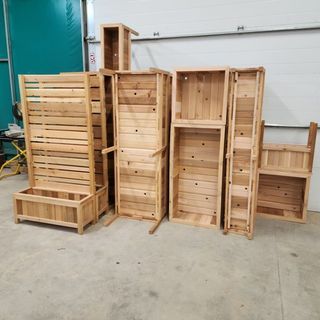
0 notes
Photo

Natural Stone Pavers in San Francisco
#Inspiration for a mid-sized modern full sun backyard stone landscaping with a fire pit. lavenders#redwood vegetable boxes#salvias#smooth stucco#orinda landscape design
0 notes
Photo

San Francisco Retaining Walls Landscape
#Inspiration for a traditional#medium-sized backyard landscape with retaining walls. belgard highland stone retaining wall#redwood fencing#berkley landscape design#pet garden#galvanized vegetable garde box
0 notes
Photo

Landscape Natural Stone Pavers in San Francisco
#Inspiration for a mid-sized modern full sun backyard stone landscaping with a fire pit. redwood vegetable boxes#smooth stucco#ashler pattern connecticut bluestone#natural stone pavers#modern landscape design#hog wire fencing
0 notes
Text

This is a new post in my series of three four about Eddie’s house on 9-1-1.
part one, part two, part three | Buck’s loft
Since 5b blessed us with lots of looks at Eddie’s room (finally!!), I wanted to do an update to my model of Eddie's house. Rather than alter my original post, I’m just making a new one to tack on. So, let’s get started.
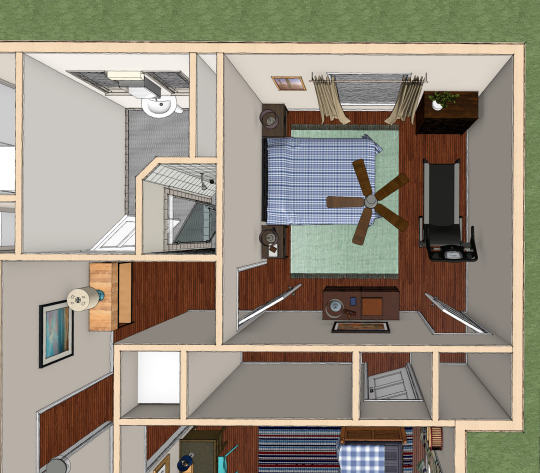
Here’s the floor plan view. They changed the door into the room from both the S2 House and from what we saw a glimpse of in S3. So the door now swings inward. They also removed a window and moved the closet from right by the door into the room to over on the other side of Chris’s closet, which makes the room bigger (And also leaves a weird empty space hiding in the walls, but it's fine. I'm fine.).
And Eddie has used his new bigger room to fit his new treadmill.
More views and details under the cut!
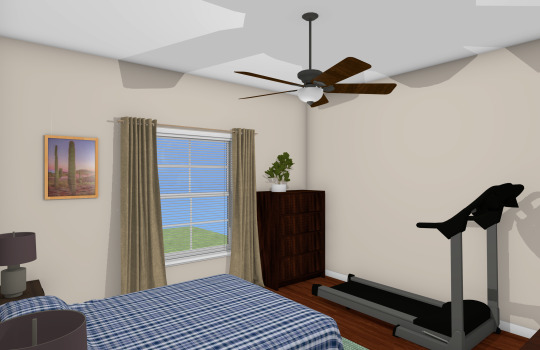
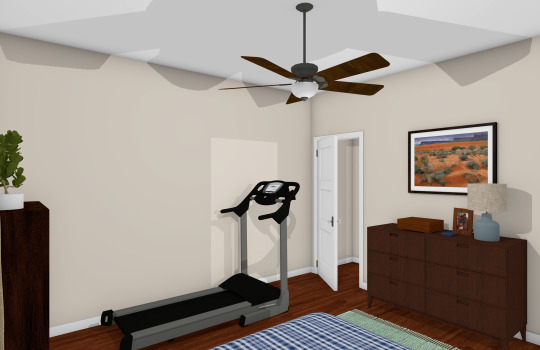
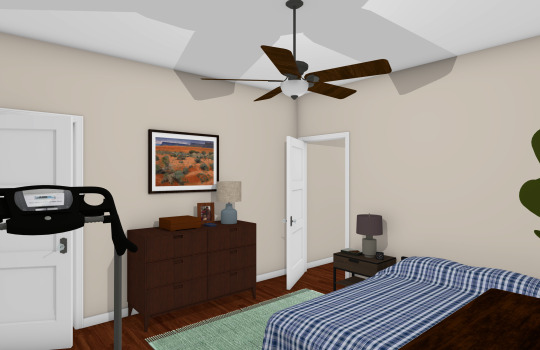
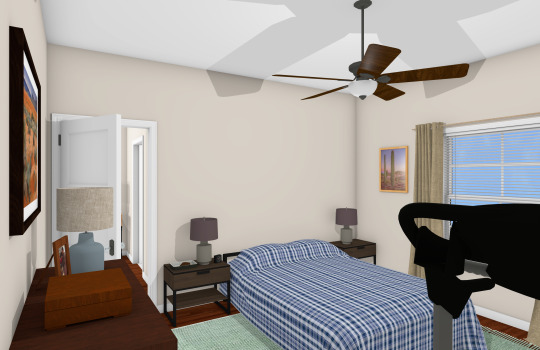
The furniture is all pretty similar to what we saw in S2 but not exactly the same. He’s got a contemporary, metal bed frame that’s either a queen or a full. There’s a very low headboard. The bedspread is blue and white plaid. The two matching end tables are wood with similar metal frames to the bed. There’s two matching lamps with sort of beige ceramic bases and kind of dark muted mauve lampshades. On the table next to Eddie’s side of the bed, closest to the door, is an analogue alarm clock and a tray to hold what I’m guessing are his pocket items like keys and wallet.
Under the bed is a large woven rug in a muted green color. And above the bed is a ceiling fan.
Across from the bed, between the door into the room and the closet door is a mid century style wood dresser. Sitting on top of this dresser is another ceramic lamp, this time in a blue color with white or beige shade. Next to that is the only visible photo in the room. It’s of Eddie and Chris hugging Shannon on Christmas in S2. In front of that is Eddie’s Silver Star. And next to that is a low profile decorative wooden box.
There’s a piece of art hanging on the wall above this dresser, but the only glimpse of it I could get was enough to know that there’s a white matte and the lower right corner is some shade of brownish. So, I’ve taken the liberty of choosing a desert art print to match the other desert art in his room. I’m pretty confident that it is actually some sort of nature art, because all of the art in Eddie’s house is nature art. The living room is tree/forest stuff with one water fall. The dining room and hallway are ocean and water. Chris has his own stuff, but there’s also the Redwood poster and he has a lot of animals. And Eddie’s room seems to be desert themed, which is why I stuck with desert for this mystery art.
Along the far wall is the treadmill. It faces the closet door. We never got to see this wall pre destruction, so I don’t know if the destroyed frame we see in the aftermath was on this wall or was the piece from over the dresser I just discussed. So, this wall could be blank or not. There’s no telling.


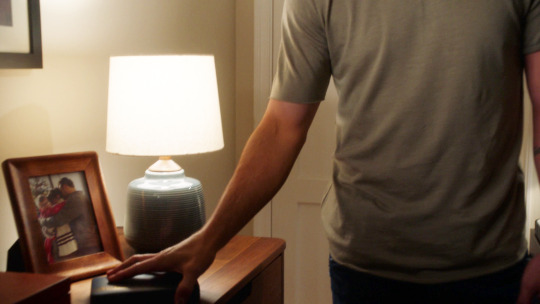

Behind the treadmill, in the corner, is another taller and narrower wood dresser. It’s got a nice bonsai tree sitting on it that looks to be a jade tree.
In shots of Eddie’s destroyed room when Buck breaks down the door, there’s a floor lamp next to this dresser that is not visible in any of the shots from 5x11, so I didn’t add it here. My take is that that lamp was added specifically in that scene for lighting and effect. There’s also a wicker basket that I assume is for laundry next to Eddie when he’s crying with the bat, but I’m not sure where in the room it normally lives.
Next to the dresser is the only window in the room, which is centered on the wall. There are some light brown/beige blackout curtains and also mini blinds for window treatment. There's vegetation visible outside the window.
On the other side of the window is a small piece of art. It’s a pretty desert scene in blues and pinks with saguaro cacti at either sunrise or sunset.
And there you have it. Eddie’s room!
If you got this far, thanks for reading all of this. I hope this is helpful or at least interesting. 💕
#eddie diaz#911 fox#911#911 on fox#evan buckley#911 parade of homes#made by fraddit#911 by fraddit#shut up fraddit
277 notes
·
View notes
Photo




Fossils
As regular visitors have heard many times this season, winter in Vancouver doesn’t offer many opportunities to photograph garden flowers. Recently I’ve been “thinking outside the box” and I’ve posted photos of a painted fence and earlier, some autumn leaves, so now I’m going to continue to work this strategy with a tour of my plant fossils. I’ve put a Bic lighter in each photo to give a sense of scale and to introduce some much needed color to otherwise dull rocks.
a) Ginkgo biloba is a living fossil and first evolved 290 million years ago. Gingkoes once dominated Jurassic landscapes but this is the only species that survives to modern times. It’s closest living relatives are cycads. One of my neighbors has a ginkgo in his front yard.
b) Metasequoia (Dawn redwood) The Dawn redwood is another living fossil. Believed extinct since the Eocene it was rediscovered in Hubei, China in the early 1940′s and became an international hit as an ornamental tree. We have four of them growing in front of our local vegetable store. This fossil was found by my kids in Driftwood Canyon when they were little shavers.
c) This fossil looks like a woodchip and people are always surprised when they pick it up and they realize it’s petrified.
d) Beech (Fagus) is a genus of deciduous trees in the family Fagaceae, native to Europe, Asia and North America. They first evolved about fifty million years ago but this fossil looks like it fell last October.
154 notes
·
View notes
Text
Few Helpful Tips on Buying Raised Garden Beds

A raised bed is a good choice if you want to have a healthy and productive garden. They are easy to build, are easy to maintain, and are a great way to get your vegetables off the ground and into your kitchen. There are several advantages to using these beds, but there are some things you should consider before you buy them. Read on for helpful tips! Also, keep in mind that some of these beds are not oriented properly. This is an important factor to consider when planning your layout.
Raised garden beds can be made of different materials. Wood, secondhand bricks, pallets, and wooden sleepers are the cheapest options. You can even customize them to match your theme. If you have a high-end theme, you can spend a little extra and opt for concrete sleepers or large stones. These are more expensive than straw bales, but the material will last for decades. Buying raised garden beds is a smart investment and will pay for themselves in food!
If you can afford it, you should buy raised garden beds made of cedar or redwood. These are both softwoods, and should last for several years if properly maintained. However, you should consider the watering schedule of your plants. If your plants don't get enough water, they might not grow well. In addition, it is also important to check the moisture level with a finger. The moisture level of your garden bed is important for proper growth.
The location is also very important. Ensure that it gets at least 6 hours of direct sunlight each day. If you can't find a level spot, level the ground. Then make sure that the area is not shaded or has tree roots. Remove the lawn before adding soil to the bed. The soil should be moist enough to prevent weeds from growing. The best location for a raised bed is where it receives the most sunlight and is free from pollution.
Modern raised garden beds are an excellent choice for a backyard garden. These durable structures can protect your plants from pets and are perfect for growing herbs, vegetables, and fruits. In addition, you will be able to easily water your plants. Moreover, your raised beds will stay in good shape and will be easy to maintain. And when you buy raised garden boxes, you will get a great deal for your money. It will help you grow more food.
When buying raised garden beds, make sure to check the water supply system. A good way to check this is by sticking a finger into the bed and observing how much moisture is present. It should be moist enough to support the plants. Ensure that the water supply system is working properly. You should be able to easily see when the plants have enough water. Always remember to keep your plants hydrated at all times. In this case, the height of the plants should not exceed 18" because this may cause structural problems.
When you buy raised garden beds, you should check the proportion of topsoil and compost in the soil. Experts recommend that there should be a ratio of 60 percent topsoil to 30 percent compost in the soil. In addition to the organic matter, you should also check the moisture level of the soil. If it is dry, you may need to add a bit of peat to the soil. In either case, the right proportion of water is essential for a healthy plant.
Some types of plants require stump removal, so you might need to choose a raised bed that protects the roots and avoids this. This is a major disadvantage of the former, and it is a good choice for those who are handy. For the latter, a raised bed is the best choice for the home-grown vegetable garden. If you are handy, you can make a simple, inexpensive, and durable garden bed.
When you buy raised garden beds, you need to choose the right type of soil. It is very important to choose the right type of soil based on the type of plants you're planning to grow. You can buy a pre-mixed soil or select a mixed soil for your garden. There are many advantages to screened topsoil. Its quality will depend on what kind of plants you want to grow.
2 notes
·
View notes
Note
the bittersweet feeling when ayla finds out that in another timeline cayde is alive and safe. they live together. cayde bought something special and ayla knows but pretends she doesn't and one afternoon while they are sitting on top of the tower, with his voice box shaking from the nerves, he pulls out a little box with a little ring inside and he's not done saying the word 'marry' that she screams YESYESYEY and hugs him so hard they fall from the wall, still holding each other after Sundance and Spectre ress them and they are laughing and crying and kissing.
She thinks of her own cayde, cold and buried, and herself, alone and bitter, and wonders if she should be glad they are happy in a kinder world, or furious of the chance they lost in this one.
Ayla would torture herself, asking the Stranger about all the different timelines. How she and Cayde live their lives, how they have to fight together, work together, survive together.
There is one that she loves in particular where she and Cayde leave the last city. They find a remote location somewhere in the northern redwoods of California, or the thick forests of Oregon, Elsie can't recall exactly, the timelines had ended up so mixed and muddied.
But they spend the time building a home, literally. It's from scratch, with hidden rooms for Cayde to stash things like he loves to do. But it's home, and it's perfect. When it's finished, it's in front of that home where he gets down on one knee, where he askes Ayla to marry him. It's where she says yes. And it's where they raise their family.
Colonel has long since passed on, but her babies had made their home in a roost out back, roosters and hens alike with chicks running around happily. They've managed to collect a small army of cats, have made friends with the local crows. And eventually, they receive a letter from Mithrax about a small Eliksni child that needs a family. Since Cayde can't produce children of his own, they welcome her/him into their home with open arms.
Over time, their home grows, Zavala and Ikora make it a habit to come visit them during the summer. Eris sends her regards occasionally, and the Drifter is more like the crazy uncle to their Eliksni child. He tells her/him stories of creatures that humans use to ride called horses, teaches them how to fish, how to hunt, how to sneak around the house until Ayla has to slap him across the back of the head, laughing the entire time.
Fall arrives and they gather the leaves into massive piles letting their child play in them until the sunsets. They make pies and, despite Cayde's initial protests, their holiday dinners are made with chicken and the vegetables Ayla had taken to growing in the front yard. Pumpkins litter the porch, some with carved faces, some just painted colorfully.
In the winter, they build snowmen(guardians/Eliksni), make snow angels, build igloos and catch snowflakes. They watch as ice eventually crystalizes on their windows, the fireplace becoming the main gathering point of the house. They pass the time baking and cooking, reading books Ayla procured from old buildings. They play card games and old games with marbles and rocks.
When the snow melts into spring, Ayla goes about planting seasonal fruits and vegetables. Their little Eliksni hatchling has grown into a strong adult, towering over both Ayla and Cayde. Eventually, they fly the coop and begin making their name in the skies. Cayde and Ayla watch, listen, and feel nothing but pride for their children. It's this timeline that she thinks of every night as she lay in her cot, avoiding the apartment that is nothing but pain to her. A memory that will never grow.
4 notes
·
View notes
Text
Sacred Spaces
“Nature is the original church. Worship there daily.” Alan Cohen
If we have learned anything from the pandemic of the past eighteen months, it is that our greatest blessing is to be able to go outdoors to breathe fresh air. Many people choose to hike the hills, walk the reservoir, or take a jaunt to the ocean to calm nerves and preserve sanity. For those of us fortunate enough to have a garden, balcony, porch, or patio, we can open a door to escape the confines of lockdown.
The majesty of Mother Nature rivals the most exquisite man-made cathedral. Throughout my landscape, I have designed special areas that stimulate my senses, inducing a sense of tranquility and connectivity with the natural world. I have dubbed these my “sacred spaces”, places where I can meditate, watch the wildlife, listen to birdsong, commune with the breeze, rest my weary legs, take a nap, or just sit and contemplate life. My “sacred spaces” provide a structure amidst the chaos, a respite against the turmoil of the times.
We can expand our living environment by crafting outdoor elements that nurture our spirits, emotions, and bodies. Here are a few of my favorite strategies to help gardeners recast their yards into a serene, yet lush oasis.
Water
The sound of water is immensely soothing. Listening to the gurgling of a fountain or the rippling of a stream heightens my creativity. Birds splashing in a birdbath bring a smile to my face. A pond with a recirculating pump provides a happy home for frogs, and if deep enough, fish.
Hammock
Hanging a hammock from two trees is the ultimate in shaded relaxation. I have double hammocks strung between a giant magnolia and Japanese maples. There is nothing quite like swaying in the hammock looking up at the light as it dances between the branches. The colors of the leaves are forever changing. For an afternoon nap on a hot day, a hammock provides a piece of paradise.
Swing
I’ve installed a metal garden swing behind my pond flanked by orange Birds of Paradise and midnight blue agapanthus. By adding comfy cushions, I can silently swing while listening to the aerating pond and watching the aerial antics of squirrels spiraling through the loquat tree.
Tables, Chairs, and Benches
Throughout my landscape, I have placed multiple tables, chairs, and benches in specific areas to encourage me to take a break from the hard labor. A wooden picnic table under an apple tree begs me to take a lunch period. A bench facing the hills beckons me to behold a doting doe with her twin fawns as they forage. A small rocking chair in a cozy nook allows me to remove my mud boots and watch the sunset.
Paths and Walls
Whether you use gravel, bricks, decomposed granite, pavers, or flagstone, creating paths throughout the garden allows for interesting patterns and yard exploration. Because I believe in recycling, upcycling, and repurposing, I always utilize whatever materials are available when I’m building stairs, paths, or walls. A former built-in redwood bench is turned on its side to be reused as a retaining planter box. Used bricks add a separation element to the revamped below-deck walkway bordering the tangled wisteria forest.
Pergolas, Gazebos, Decks
A deck is always a great gathering spot. A gazebo or pavilion is a stately structure to sit, embrace the view, and offer gratitude for outdoor rooms. On my deck, under my grape, wisteria, and bower vine-covered pergola, I unwind after a long day by soaking in the hot tub. This is my prayer place as I gaze at the twinkling stars above.
Plantings
The selection of specific plants is critical to the overall color and scale of any garden. My goal is always to witness botanical interest 365 days a year through express attention to the trees, flowers, shrubs, bulbs, vegetables, herbs, and bushes. Every season brings a change to the landscape. Roses bloom for nine or ten months when regularly dead-headed. Perennial sweet peas flourish with their pretty purple pea heads from spring until autumn. Pink naked ladies pop up to smarten the summer soils when most other plants find it too hot to shine. Deciduous trees such a Japanese maple, pistache, crape myrtle, and liquid amber offer spectacular autumn colors.
When you think about creating your sacred spaces, make sure you are bringing the indoors out and the outdoors in. Expand your home environment by mimicking and mingling colors, patterns, themes, and shapes through both areas. Great design amplifies your emotional well-being. Rediscover forgotten or overlooked spots. Feel the vibes as you develop your scheme keeping comfort and safety at the forefront. Use your imagination to unearth the endless possibilities.
Mother Nature is the original church. When we honor Her, we will attain a more balanced life with peace as a bonus gift, no matter what is happening around us. As this latest Delta variant spreads its dangerous virus tendrils, I urge everyone to talk with their physicians, listen to the science, and get vaccinated. Discover your sacred space, breathe, and spend as much time outdoors as possible.
A Be the Star You Are!® volunteer from Minnesota emailed me “I go for walks on our nearby trail as often as I can because it’s a way to escape to nature, and I know how you feel about that! So off I go.”
Off you go!
MARK YOUR CALENDARS!
Saturday, September 25th, Be the Star You Are!® will participate in the first live event at the Pear and Wine Festival with a booth sponsored by the Lamorinda Weekly(www.Lamorindaweekly.com) and MB Jessee painting (www.MBJessee.com). Wear your mask and visit us! Details at https://www.bethestaryouare.org/copy-of-events
Phots and more: https://www.lamorindaweekly.com/archive/issue1513/Digging-Deep-with-Goddess-Gardener-Cynthia-Brian-Sacred-spaces.html
Press Pass: https://blog.voiceamerica.com/2021/08/18/sacred-spaces/
Happy Gardening. Happy Growing.
Cynthia Brian, The Goddess Gardener, is available for hire to help you prepare for your spring garden. Raised in the vineyards of Napa County, Cynthia is a New York Times best-selling author, actor, radio personality, speaker, media and writing coach as well as the Founder and Executive Director of Be the Star You Are!® 501 c3. Tune into Cynthia’s StarStyle® Radio Broadcast at www.StarStyleRadio.com.
Buy copies of her books, including, Chicken Soup for the Gardener’s Soul, Growing with the Goddess Gardener, and Be the Star You Are! www.cynthiabrian.com/online-store. Receive a FREE inspirational music DVD and special savings.
Hire Cynthia for writing projects, garden consults, and inspirational lectures.
www.GoddessGardener.com
2 notes
·
View notes
Photo


Update! Me and @beautifultrees07 built these planter boxes today! The sun set and we ran out of screws before we could start the compost box I mentioned in previous posts but it’s a great start to a future vegetable garden! Some of the square dowels had knots in them (impossible to drill through) so we had to drill around them or be mindful of the positioning/switch out some dowels. Other than that, it was pretty smooth and easy for two people who rarely work with wood. I chose cedar instead of redwood for these boxes because it was cheaper and I hear cedar is more resistant to rotting when it comes in contact with water. All together, paying for materials and wood cutting services for two planter boxes (at home depot) cost $43 before tax ($47.05 after tax)
59 notes
·
View notes